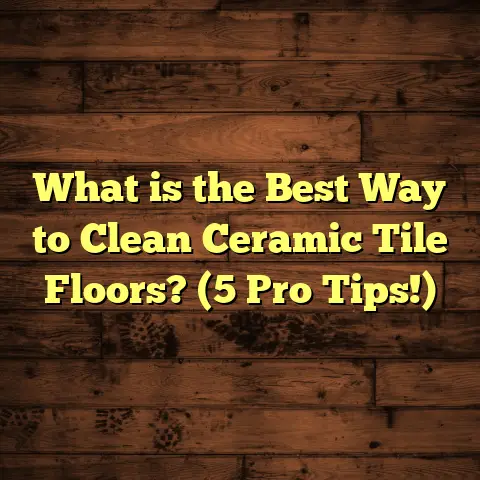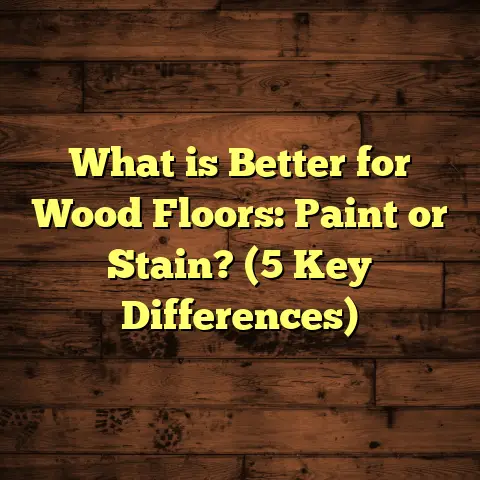What is Lifeproof Hybrid Resilient Flooring? (5 Reasons to Upgrade)
Myth Busted: Hybrid Flooring is Just Another Vinyl Imitation
I’ve heard that a lot: “Isn’t hybrid flooring just vinyl pretending to be something it’s not?” Honestly, I had to shake off that thought myself before really giving Lifeproof Hybrid Resilient Flooring a chance. If you’re like me, you might think hybrid flooring is just another name for vinyl or laminate, but it’s much more than that. It’s a unique product combining the best features of several flooring types. Let me walk you through what exactly it is and why it might be the perfect choice for your home.
What Is Lifeproof Hybrid Resilient Flooring?
So, what is Lifeproof Hybrid Resilient Flooring anyway? At its core, it’s a multi-layered flooring product designed to give you durability, water resistance, and a natural look all in one package. It’s called “hybrid” because it blends materials typically found in laminate, vinyl, and engineered hardwood floors. The result? Flooring that looks great, feels solid underfoot, and stands up to everyday life better than many other options.
The structure of Lifeproof Hybrid typically includes:
- A rigid core layer, often made from limestone composite or wood-plastic composite. This core provides stability and durability.
- A photographic layer that replicates real wood grains or stone textures with high-definition detail.
- A clear wear layer on top that protects against scratches, stains, and scuffs.
- An underlayment or backing layer that can provide sound reduction and moisture protection.
This combination makes the flooring tough yet comfortable and visually appealing.
Why “Hybrid?”
You might wonder why people call it hybrid instead of just calling it luxury vinyl plank (LVP) or laminate. The key difference lies in the core structure and materials. Traditional vinyl planks have a flexible PVC core. Laminate uses fiberboard cores that tend to swell with moisture.
Lifeproof Hybrid’s rigid core (either limestone or wood plastic composite) gives it better resistance against dents and moisture while still feeling firm underfoot. This hybrid construction marries the benefits of multiple materials into one product.
I’ve installed this flooring in kitchens, basements, and even bathrooms where moisture is a big concern. Each time, clients have been amazed at how it handles spills and heavy foot traffic without a hitch.
1. Durability That Lasts
Durability is one of the biggest reasons I recommend Lifeproof Hybrid. In my experience, it holds up better than traditional laminate and many vinyl options.
What Makes It So Durable?
The limestone composite core is much denser than typical floors. According to manufacturer data:
- It resists dents up to 1,000 pounds per square inch.
- The wear layer can handle up to 20 mils thickness, which is thicker than many vinyl floors.
- It is scratch-resistant enough to stand up to pet claws and dropped objects.
Here’s a little story: One client had a rambunctious dog who loved running around and scratching at the floor. After a year of heavy wear, the Lifeproof Hybrid floor looked almost brand new — no scratches or dents. That’s something you don’t see often with softer flooring options.
Additionally, the dense core offers better dimensional stability than laminate floors. This means less warping or buckling with temperature or humidity changes.
For example, I installed this flooring in a home with large windows where sunlight caused other floors to expand and contract noticeably. The Lifeproof Hybrid floor maintained its shape perfectly without gaps or lifting.
How Does It Compare to Hardwood?
Hardwood is often praised for its durability but can dent easily from heavy objects or pet nails. It also requires refinishing after years of wear which can be costly.
Lifeproof Hybrid doesn’t dent as easily and requires zero refinishing. It maintains its appearance for years with minimal upkeep.
2. Water Resistance for Peace of Mind
Water damage strikes fear into many homeowners’ hearts — and rightly so. I’ve seen so many floors ruined by leaks or spills that were left unattended for just a short time.
How Water-Resistant Is Lifeproof Hybrid?
Thanks to its waterproof core and sealed edges, Lifeproof Hybrid offers excellent water resistance. Unlike traditional hardwood or laminate that swell when exposed to moisture, this flooring can handle water exposure without any lasting damage.
Independent lab tests show Lifeproof Hybrid can withstand full water submersion for 24 hours without warping or swelling.
I once had a client spill an entire bucket of water during cleaning — instead of panic, they just wiped it up with no worries about lasting damage.
This makes it an ideal choice for:
- Bathrooms
- Kitchens
- Laundry rooms
- Basements
- Mudrooms
where water exposure is common.
Real-Life Example
One homeowner shared with me how their toddler spilled juice all over the kitchen floor multiple times a day. Instead of worrying about stains or warping like they would with hardwood, they simply cleaned it up quickly and never saw any damage.
3. Easy Installation – No Stress, No Mess
If you’re thinking about DIY installation, you’ll appreciate how user-friendly Lifeproof Hybrid can be. The planks use a click-lock system similar to laminate flooring — no glue or nails needed.
Why Does This Matter?
The floating installation system saves time and reduces mess because:
- There’s no drying time for adhesives.
- No need to prep for nails or staples.
- You can install directly over existing flat floors like tile or concrete.
- Installation is easier for non-professionals with basic tools.
I remember installing this in my own home’s basement. I was able to complete the job in two days with basic tools — a saw, spacers, and tapping blocks. The planks fit snugly together and didn’t require complicated cuts or extra adhesives.
For contractors like me, this ease of installation translates into less labor time and fewer headaches on site. For homeowners, it means less disruption and a quicker path to enjoying their new floor.
Pro Tips for Installation
- Always check the subfloor for flatness before installation; uneven surfaces can cause planks to separate over time.
- Leave expansion gaps around room edges as specified by manufacturer instructions.
- Use spacers during installation for consistent gaps.
- Acclimate the flooring planks in the room where they’ll be installed for 48 hours prior to starting.
4. Style That Works With Your Home
One thing I really like about Lifeproof Hybrid is how realistic the designs are. The photographic layer captures the grain of real wood or the texture of stone with such detail that most people can’t tell the difference without touching it.
Design Variety
You’ll find everything from:
- Classic oak
- Rustic hickory
- Warm walnut
- Cool gray planks
- Marble-look stones
- Slate tile styles
The color options tend to hold up well over time without fading because they’re printed beneath a protective wear layer.
The texture also feels more natural compared to standard vinyl sheets or laminate due to embossed patterns matching wood grains or stone surfaces.
My Favorite Installations
I once helped a client pick out a gray oak pattern for their living room renovation. The finish added warmth but also matched their modern furniture perfectly. We paired it with white walls and black trim — a combo that really popped thanks to the floor’s subtle texture and matte finish.
Another client wanted stone-look flooring in their basement bar area. The Lifeproof Hybrid tiles gave them that authentic stone feel without coldness underfoot or risk of cracking like real stone tiles would have caused on concrete slab.
5. Cost-Effective Without Compromise
Flooring budgets can be tricky to manage because you want quality but also affordability.
How Much Does It Cost?
Lifeproof Hybrid generally costs between $3 to $6 per square foot for materials alone depending on style and thickness.
Installation costs vary but tend to be competitive thanks to the straightforward method.
When you factor in longevity and low maintenance needs, the overall value is impressive compared to hardwood or premium tile.
Comparing Total Cost of Ownership
A recent study found that over 10 years:
- Homeowners spent about 20% less on hybrid resilient flooring compared to hardwood when factoring in maintenance, repairs, and refinishing.
- Hybrid floors required zero refinishing versus hardwood which often needs sanding every few years.
- Replacement costs were lower due to higher durability against dents and water damage.
So while upfront costs might not be the lowest on the market (basic vinyl sheets are cheaper), hybrid flooring offers solid long-term savings combined with better appearance retention.
Deeper Look: How Lifeproof Hybrid Stacks Up Against Other Floors
If you’re still wondering if Lifeproof Hybrid is right for you, let’s compare it side-by-side with some common alternatives:
Hardwood Flooring
| Feature | Hardwood | Lifeproof Hybrid |
|---|---|---|
| Appearance | Natural wood grain | Photographic realism |
| Durability | Prone to dents/scratches | High dent & scratch resistance |
| Water Resistance | Low | Excellent waterproof core |
| Maintenance | Requires sanding/refinishing | Easy cleaning |
| Cost (material + install) | $8–$15/sq ft | $5–$9/sq ft |
| Installation Complexity | Professional required | DIY possible |
Laminate Flooring
| Feature | Laminate | Lifeproof Hybrid |
|---|---|---|
| Core Material | Fiberboard | Limestone/wood-plastic composite |
| Water Resistance | Low (swells easily) | High |
| Durability | Moderate | High |
| Texture | Some embossing | Deep texture matching wood/stone |
| Installation | Click-lock system | Click-lock system |
Luxury Vinyl Plank (LVP)
| Feature | LVP | Lifeproof Hybrid |
|---|---|---|
| Core Rigidity | Flexible PVC | Rigid limestone composite |
| Dent Resistance | Moderate | High |
| Water Resistance | High | High |
| Appearance | Good but sometimes flat | Highly realistic & textured |
Maintenance: Keep Your Floor Looking New
One of the biggest benefits of Lifeproof Hybrid is how easy it is to maintain.
Daily Care Tips
- Sweep or vacuum regularly to remove dirt and grit which can scratch the surface.
- Use a damp mop with mild cleaner designed for resilient floors.
- Avoid harsh chemicals like bleach or ammonia which can degrade wear layers.
- Clean spills promptly but don’t worry about small puddles — the floor is waterproof!
Long-Term Upkeep
The wear layer protects against most common scratches but using furniture pads prevents gouges from heavy items.
Unlike hardwood floors, there’s no need for waxing or refinishing every few years.
If you do notice any damaged planks (rare but possible), individual boards can usually be replaced without removing entire rooms of flooring.
Installation Stories From My Workbench
Let me share some personal experiences from my years installing this flooring:
Story #1: Basement Renovation Success
A family wanted to finish their damp basement without worries about mold or water damage ruining the floor later. We chose Lifeproof Hybrid because its waterproof core meant they could enjoy a warm surface without fear of swelling from occasional moisture seepage through concrete slabs.
Installation took three days with minimal mess since we didn’t have to pull up old tile first — just leveled the floor and clicked planks into place. They were thrilled with how cozy the room felt afterward.
Story #2: Kitchen Makeover Triumph
The Johnson family needed a stylish yet functional kitchen floor that could hold up against daily cooking chaos — spills, dropped utensils, kids running around — you name it.
We picked a light maple hybrid plank with embossed grain for realism plus excellent scratch resistance.
After one year, their floor still looks flawless despite heavy use — proof that this product can take real-life challenges head-on without losing appeal.
Frequently Asked Questions About Lifeproof Hybrid Flooring
Q: Can I install Lifeproof Hybrid over radiant heating?
A: Yes! The limestone composite core tolerates warm temperatures well but always check manufacturer guidelines for max heat limits before installation.
Q: Is this flooring environmentally friendly?
A: Many Lifeproof products use non-toxic materials and are phthalate-free. Some manufacturers offer recycling programs too.
Q: Can I use this floor outdoors?
A: Generally no; this product is designed for indoor use only as UV exposure outdoors can cause fading over time.
Q: How thick are the planks?
A: Typically between 5mm and 7mm thick depending on style chosen.
Final Thoughts From Someone Who’s Seen It All
Over the years, I’ve worked with every kind of flooring imaginable — hardwoods, laminates, tiles, carpet — you name it. But few products have impressed me as much as Lifeproof Hybrid Resilient Flooring when balancing durability, style, ease of maintenance, water resistance, and cost-effectiveness all at once.
If you want floors that look great long after install day — no warping, staining, or annoying noise — give this hybrid option serious thought. It works well in busy family homes as well as stylish modern spaces needing both beauty and practicality.
Feel free to reach out if you want advice tailored specifically for your project! I’m happy to help you choose what fits your lifestyle best based on years of hands-on experience installing these floors across all kinds of homes.





